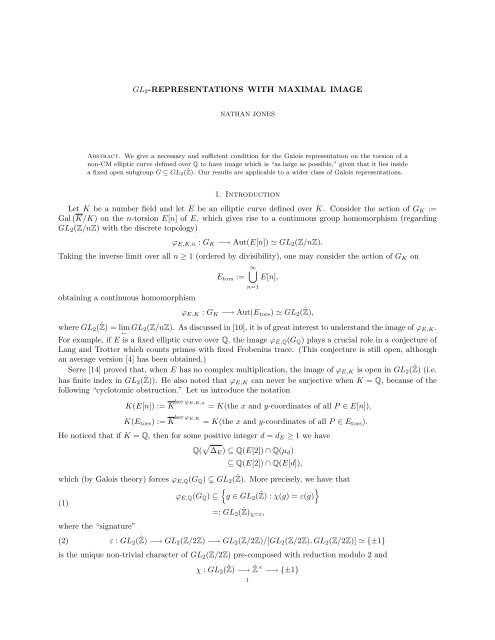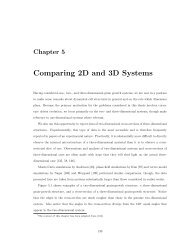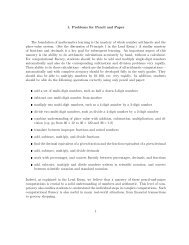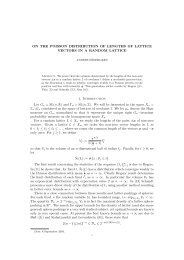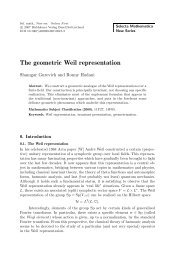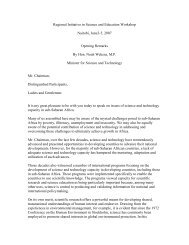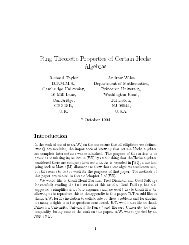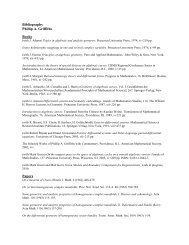GL2-representations with maximal image - Hausdorff Research ...
GL2-representations with maximal image - Hausdorff Research ...
GL2-representations with maximal image - Hausdorff Research ...
Create successful ePaper yourself
Turn your PDF publications into a flip-book with our unique Google optimized e-Paper software.
[]Furthermore, one can show (see Corollary 5.12 <strong>with</strong> G = ϕ(G Q )) that the index ϕ(G Q ) ∩ SL 2 (Ẑ) : [ϕ(G Q), ϕ(G Q )]is finite, which implies that there is a finite index subgroup H ϕ ⊆ ϕ(G Q ) so that)[ϕ(G Q ), ϕ(G Q )] = H ϕ ∩(ϕ(G Q ) ∩ SL 2 (Ẑ) .By Galois theory, we haveQ(E tors ) Hϕ · Q cyc = Q(E tors ) [ϕ(G Q),ϕ(G Q )] ⊇ Q(E tors ) ϕ(G Q)∩SL 2(Ẑ) = Q cyc .Since Q(E tors ) Hϕ is an abelian extension of Q and since Q ab = Q cyc , this implies that we must have equalityin (6):[ϕ(G Q ), ϕ(G Q )] = ϕ(G Q ) ∩ SL 2 (Ẑ).This motivates the following definitions.Definition 2.1. A subgroup H ⊆ GL 2 (Ẑ) is called commutator-thick if[H, H] = H ∩ SL 2 (Ẑ).Definition 2.2. A subgroup H ⊆ GL 2 (Ẑ) is called determinant-surjective if det(H) = Ẑ× .Remark 2.3. The above discussion shows that ϕ E,Q (G Q ) ⊆ GL 2 (Ẑ) is always a commutator-thick, determinantsurjectivesubgroup.Recall that G ⊆ GL 2 (Ẑ) is a fixed subgroup of finite index, and imagine now that ϕ E,Q(G Q ) ⊆ G. Thefollowing definition captures the notion of ϕ E,Q being “as surjective as possible onto G.”Definition 2.4. We call a commutator-thick subgroup H ⊆ G a G-<strong>maximal</strong> commutator-thick subgroupof G if H ∩ SL 2 (Ẑ) = [G, G].Our main result is the following theorem, which characterizes G-<strong>maximal</strong> commutator-thick subgroupsof G in terms of criteria which are in practice checkable. Recall the set-up: m ≥ 1 is any positive integer,G(m) ⊆ GL 2 (Z/mZ) is an arbitrary subgroup, and G := π −1 (G(m)) ⊆ GL 2 (Ẑ) is the full pre-<strong>image</strong> of G(m)under the natural projection. Define the positive integer m 0 by⎛ ⎛⎞ ⎛⎞⎞(7) m 0 := lcm ⎜⎝ 36, ∏⎜⎝ l 2ord l(m)+1⎟⎠ ·∏⎜⎝l ord l(m)+1⎟⎟⎠⎠l|mG(l) abelianl|mG(l) non-abelianTheorem 2.5. Let H ⊆ G be a determinant-surjective, commutator-thick subgroup of G. Then H is aG-<strong>maximal</strong> commutator-thick subgroup of G if and only if, for each n ∈ {m 0 } ∪ {l prime : l ∤ m 0 }, one has[H(n), H(n)] = [G(n), G(n)].We remark that, since for all odd l, [GL 2 (Z/lZ), GL 2 (Z/lZ)] = SL 2 (Z/lZ) (this follows from (10) below),Theorem 2.5 is equivalent to the following theorem.Theorem 2.6. Let H ⊆ G be a determinant-surjective, commutator-thick subgroup of G. Then H is aG-<strong>maximal</strong> commutator-thick subgroup of G if and only if the following two conditions hold.(1) For each prime l not dividing m 0 , one has SL 2 (Z/lZ) ⊆ H(l).(2) One has [H(m 0 ), H(m 0 )] = [G(m 0 ), G(m 0 )].Returning to our original example of an elliptic curve, we make the following definition.Definition 2.7. An elliptic curve E over Q which satisfies ϕ E,Q (G Q ) ⊆ G is called a G-Serre curve ifϕ E,Q (G Q ) is a G-<strong>maximal</strong> commutator-thick subgroupIf the group G is understood, one may refer to a G-Serre curve simply as a relative Serre curve. As animmediate corollary of Theorem 2.5, we will give a characterization of G-Serre curves. For any positiveinteger n ≥ 1, define the following set of subgroups of G(n):M G (n) := {H(n) ⊆ G(n) : [H(n), H(n)] [G(n), G(n)]}.3
Let X(n) denote the complete modular curve of level n, which parametrizes elliptic curves, together <strong>with</strong>chosen Z/nZ-bases of E[n]. If H is a subgroup of GL 2 (Z/nZ) such that −I ∈ H and the determinant mapdet : H −→ (Z/nZ) ×is surjective, then the quotient X H := X(n)/H is a curve over Q. Furthermore, there is a one-to-onecorrespondenceX H (Q) non-cusp. ←→ {E/Q : ϕ E,Q,n (G Q ) ⊆ H}between the non-cuspidal rational points of X H and the set of (Q-isomorphism classes of) elliptic curvesE/Q having the property that ϕ E,Q,n (G Q ) is contained in some conjugate of H in GL 2 (Z/nZ).Corollary 2.8. Let E be an elliptic curve over Q for which ϕ E,Q (G Q ) ⊆ G. Then E fails to be a G-Serrecurve if and only if, for some n ∈ {m 0 } ∪ {l prime : l ∤ m 0 } and some H ∈ M G (n), E corresponds to apoint in X H (Q) non-cusp. .Suppose we choose the groupG = π −1 (G(m)) ⊆ GL 2 (Ẑ)as above so that the corresponding modular curve X G(m) has genus zero and satisfies X G(m) (Q) ≠ ∅, andsuppose thatE : y 2 = x 3 + A(t)x + B(t) (A(t), B(t) ∈ Q(t))is an elliptic curve over Q(t) satisfyingϕ E,Q(t) (G Q(t) ) = G.(Note in particular that E then defines a morphism P 1 −→ X G(m) .) For a real parameter T ≥ 0, define thesetsF E (T ) :={t 0 ∈ Q : H(t 0 ) ≤ T, E t0 /Q is an elliptic curve},E E,non-G-Serre (T ) :={t 0 ∈ F E (T ) : E t0 is not a G-Serre curve},where E t0 denotes the specialization of E at t 0 and H(t 0 ) denotes the Mordell height of t 0 , i.e. if we writet 0 = a/b in lowest terms,H(a/b) := max{|a|, |b|}.Corollary 2.8 allows us to deduce the following generalization of [3, Main Theorem].Theorem 2.9. Let ε > 0 be arbitrary. One has|E E,non-G-Serre (T )| = O E,ε (T 1+ε ).Since |F E (T )| ≍ T 2 , Theorem 2.9 implies that “almost all specializations of E are G-Serre curves.” Themain theorem of [3] gives Theorem 2.9 when G = GL 2 (Ẑ), and also gives much better bounds in some cases.The proof of Theorem 2.9 proceeds along the same lines (<strong>with</strong> Corollary 2.8 replacing [3, Corollary 16]),and also gives better bounds in the appropriate cases. For the sake of brevity, Theorem 2.9 states only theweakest form of what one can deduce from Corollary 2.8, and (since its proof is exactly the proof of [3, MainTheorem], mutatis mutandis) we will not include it in the present paper.Remark 2.10. Suppose that H ⊆ G is determinant-surjective and commutator-thick.sequence(8) 1 −→ H ∩ SL 2 (Ẑ) −→ H −→ Ẑ× −→ 1,Noting the exactand that the kernel H ∩ SL 2 (Ẑ) = [H, H] ⊆ [G, G], it follows that, if H is a G-<strong>maximal</strong> commutator-thicksubgroup of G in the sense of Definition 2.4, then H is also <strong>maximal</strong> (<strong>with</strong> respect to subset inclusion) amongthe commutator-thick subgroups of G. Furthermore, it follows from (8) and the corresponding sequence <strong>with</strong>G replacing H that[](9) H ∩ SL 2 (Ẑ) = [G, G] ⇐⇒ [G : H] = G ∩ SL 2 (Ẑ) : [G, G] .Thus, Definition 2.4 is equivalent to H having minimal index in G.4
2.1. The general case. The definitions and theorems we have described apply more generally to the followingsituation. Let r ≥ 1 be a positive integer and let G ⊆ GL r be any algebraic subgroup. Fix a positiveinteger m ≥ 1 and an arbitrary subgroup G(m) ⊆ G(Z/mZ), and let G := πG(Ẑ)(G(m)) −1 ⊆ G(Ẑ) denote thecorresponding finite index subgroup of G(Ẑ). Furthermore, suppose thatis any representation for which the compositionϕ : G Q −→ Gdet ◦ϕ : G Q −→ Ẑ×agrees <strong>with</strong> the cyclotomic character. Definitions 2.1, 2.2 and 2.4 (<strong>with</strong> GL 2 (Ẑ) and SL2(Ẑ) replaced byGL r (Ẑ) and SLr(Ẑ), respectively) each make sense for any subgroup H ⊆ G, and (for the same reason as inthe GL 2 case) the <strong>image</strong> ϕ(G Q ) must be commutator-thick and determinant-surjective.Let us now make the following assumptions about the group G. Let S := G ∩ SL r .A1 There is a finite set P 1 of primes such that, for any prime l /∈ P 1 , there is a simple group P S(l)and a surjective homomorphism ϖ : S(Z/lZ) → P S(l), <strong>with</strong> no proper subgroup T (l) S(Z/lZ)satisfying ϖ(T (l)) = P S(l). Furthermore, if l, l ′ /∈ P 1 and l ′ ≠ l, then P S(l ′ ) does not occur as aquotient of a subgroup of S(Z l ).A2 There is a finite set P 2 of primes such that, for any prime l /∈ P 2 there is no proper subgroupT (l 2 ) S(Z/l 2 Z) satisfying π(T (l 2 )) = S(Z/lZ), where π : S(Z/l 2 Z) → S(Z/lZ) denotes thecanonical projection.A3 For every prime l, the Lie algebra g attached to the l-adic lie group G(Z l ) satisfies〈CD − DC : C, D ∈ g〉 = {X ∈ g : tr X = 0},where we are viewing g ⊆ M r×r (Z l ) and interpreting the Lie bracket [, ] as [C, D] = CD − DC.Having made these assumptions on G, we put⎛⎞m gen∏0 := lcm ⎜⎝ l 3 ,l∈P 2∪P 1∏l /∈P 2∪P 1l|ml 2ord l(m)+1Our proof of Theorem 2.5, formulated generally, gives the following result.Theorem 2.11. Let G ⊆ GL r be any algebraic subgroup satisfying assumptions A1, A2 and A3 above,m ≥ 1 a positive integer, G(m) ⊆ G(Z/mZ) any subgroup and G = πG(Ẑ)(G(m)) −1 ⊆ G(Ẑ) the correspondingfinite index subgroup. Let H ⊆ G be a determinant-surjective, commutator-thick subgroup. Then H is aG-<strong>maximal</strong> commutator-thick subgroup of G if and only if the following two conditions hold.(1) For each prime l not dividing m gen0 , one has S(Z/lZ) ⊆ H(l).(2) One has [H(m gen0 ), H(m gen0 )] = [G(m gen0 ), G(m gen0 )].⎟⎠ .2.2. The case G = GL 2 (Ẑ). We end this section by remarking on the situation when G = <strong>GL2</strong>(Ẑ). In thiscase, we have(10) [GL 2 (Ẑ), <strong>GL2</strong>(Ẑ)] = SL2(Ẑ) ∩ ker ε,where ε is defined in (2) (for a proof of this, see for instance [6]). Thus, putting G = GL 2 (Ẑ) in (9), we findthat, for any elliptic curve E over Q,E is a Serre curve ⇐⇒ [GL 2 (Ẑ) : ϕ E,Q(G Q )] = 2In particular,E is a GL 2 (Ẑ)-Serre curve ⇐⇒ E is a Serre curve.Thus, Theorem 2.6 has the following corollary, which improves [8, Lemma 5] to an “if and only-if” statement.Corollary 2.12. An elliptic curve E over Q is a Serre curve if and only if the following two conditionshold.(1) For each prime number l ≥ 5, SL 2 (Z/lZ) ⊆ ϕ E,Q,l (G Q ).5
(2) One has [ϕ E,Q,36 (G Q ), ϕ E,Q,36 (G Q )] = SL 2 (Z/36Z) ∩ (ker ε mod 36).Remark 2.13. The fact that ϕ E,Q (G Q ) must be commutator-thick is a consequence of the Kronecker-Webertheorem, and so one cannot draw the same conclusion if E is defined over a number field K ≠ Q. Indeed, asshown in [6] (see also [16]), there are number fields K and elliptic curves E over K for which ϕ E,K (G K ) =GL 2 (Ẑ), which by (10) is not commutator-thick.3. Notation and preliminariesThroughout the paper, we will use the following notation. For positive integers n and m, we will writen | m ∞to mean that, for every prime number p, if p divides n then p divides m. The symbols p and l will alwaysdenote prime numbers. We use the usual notationẐ := lim←Z/nZfor the inverse limit of the projective system {Z/n 1 Z → Z/n 2 Z : n 1 , n 2 ≥ 1, n 2 | n 1 }. The Chinese remaindertheorem gives an isomorphismẐ ≃ ∏ lZ l ,where Z l denotes the ring of l-adic integers. We will often make implicit use of this isomorphism. For anyfixed positive integer n, we will denote by Z n (respectively Z (n) ) the subring of Ẑ which corresponds underthis isomorphism to ∏ Z l (respectively to ∏ Z l ).l|nl∤nGiven a subgroup H ⊆ GL 2 (Ẑ), we will denote by H n (respectively by H(n)) the <strong>image</strong> of H underthe canonical projection GL 2 (Ẑ) → GL 2(Z n ), (respectively under the canonical projection GL 2 (Ẑ) →GL 2 (Z/nZ)). We will overwork the symbol π, using it to denote any of the following canonical projections:π : GL 2 (Ẑ) −→ GL 2(Z n )π : GL 2 (Ẑ) −→ GL 2(Z/nZ)π : GL 2 (Z/n 1 Z) −→ GL 2 (Z/n 2 Z) (n 2 | n 1 ).We will use the symbol π SL2 ( to refer ) to the restriction to SL 2 of any of these projections.a bFor a 2 × 2 matrix g = , we denote byc d( )g Ad d −b:=−c athe classical adjoint of g. Given a ring R, we use M 2×2 (R) to denote the ring of 2 × 2 matrices <strong>with</strong> entriesin R. Furthermore, we setand, given a matrix g ∈ M 2×2 (R),tr =0M2×2 (R) := {A ∈ M 2×2 (R) : tr A = 0},N g (R) := {X ∈ M 2×2 (R) : Xg = g Ad X}.Finally, for a pair of elements h and k in any group, we will use the standard notation for the commutator:[h, k] := hkh −1 k −1 .6
4. Examples and remarksBefore proving Theorem 2.5, we will give a few examples which illustrate some of the subtlety of thisstudy. The first example highlights the fact that, even though there may exist a determinant-surjective,commutator-thick subgroup H of a given group G, there may nevertheless be no elliptic curve E over Q forwhich ϕ E,Q (G Q ) ⊆ G.Example 4.1. Let l be a prime,G(l) :={( )}a b: b ∈ Z/lZ; a, d ∈ (Z/lZ) × ,0 dand G = π −1 (G(l)) ⊆ GL 2 (Ẑ). Even though there do exist commutator-thick, determinant-surjective subgroupsH ⊆ G, Mazur has shown (see [9]) that, for l > 163, there is no elliptic curve E over Q for whichϕ E,Q (G Q ) ⊆ G. More generally, when the index of G in GL 2 (Ẑ) is large enough, one expects that no subgroupof G arises as ϕ E,Q (G Q ) for E over Q (see [14, § 4.3] and [1]).The next example shows that there do exist finite index subgroups G ⊆ GL 2 (Ẑ) which have no commutatorthick,determinant-surjective subgroups.Example 4.2. Let l be an odd prime and fix any element ε ∈ (Z/lZ) × which is not a square, i.e. for which( εl)= −1. Let C ns (l) denote the non-split Cartan subgroup{( )} x εyC ns (l) :=⊆ GLy x2 (Z/lZ).The group G := π −1 (C ns (l)) ⊆ GL 2 (Ẑ) has no subgroup H which is simultaneously commutator-thick anddeterminant-surjective.Proof. If there were a commutator-thick, determinant-surjective subgroup H ⊆ π −1 (C ns (l)) then there wouldnecessarily be a group homomorphism ψ : Ẑ× −→ C ns (l) for which the diagram(11)Ẑ × Ẑ ×⏐⏐↓red↓ψC ns (l)det−−−−→ (Z/lZ) ×commutes. We will show that such a homomorphism ψ cannot exist. Suppose for the sake of contradictionthat such a ψ does exist. The group C ns (l) is a cyclic group of order l 2 − 1, from which it follows that ψfactors asẐ ×red−−−−→ (Z/lm ′ Z) ×ψ−−−−→ ψ((Z/lm ′ Z) × ) ⊆ C ns (l),where l does not divide m ′ . Let g be a generator of C ns (l) and consider the <strong>image</strong> under ψ of (Z/lZ) × ×{1} ⊆(Z/lZ) × × (Z/m ′ Z) × . By order considerations, we must haveψ((Z/lZ) × × {1}) ⊆ 〈g l+1 〉,from which it follows by (11) (since g l+1 is a scalar matrix) that the canonical projection (Z/lm ′ Z) × →(Z/lZ) × maps into [(Z/lZ) × ] 2 , a contradiction. Thus, there is no ψ making (11) commute, proving theassertion.□Remark 4.3. By Remark 2.3, the previous example shows that∄E/Q for which ϕ E,Q,l (G Q ) ⊆ C ns (l).Our third example illustrates, among other things, that the subspace V ⊆ M 2×2 (Z/lZ) defined by theexact sequence1 → I + mV → H(lm) → H(m) → 17
may shrink when we replace m by a multiple of m. Let the split-Cartan subgroup C s (Z/l n Z) and the Borelsubgroup B(Z/l n Z) be defined as usual by{( )} {( )}C s (Z/l n x 0 x yZ) :=⊆=: B(Z/l n Z) ⊆ GL0 z 0 z2 (Z/l n Z).Let χ (1)l, χ (2)n l: B(Z/l n Z) −→ (Z/l n Z) × be the characters defined byn(( ))(( ))χ (1) x yl:= x, χ (2) x yn0 zl:= z,n0 zand let us use the same symbols to denote their corresponding restrictions to C s (Z/l n Z). Note that, ifπ −1 (C s (Z/lZ)) ⊆ GL 2 (Z/l 2 Z) denotes the full pre-<strong>image</strong> of C s (Z/lZ), then there is a surjective grouphomomorphismµ : π −1 (C s (Z/lZ)) −→ C s (Z/l 2 Z)(( )) ( )x + 3a 3b x + 3a 0µ:=.3c z + 3d 0 x + 3dFinally, we use L l : (Z/lZ) × −→ (Z/3Z) × to denote the (unique) surjective homomorphism which sends agenerator of (Z/lZ) × to −1.Example 4.4. Suppose that G ⊆ GL 2 (Ẑ) is a subgroup <strong>with</strong>{}G(3 · 7 · 13) = (g 3 , g 7 , g 13 ) ∈ C s (Z/3Z) × B(Z/7 · 13Z) : det(g 3 ) = L 7 (χ (1)7 (g 7)), χ (1)3 (g 3) = L 13 (χ (1)13 (g 13)) .It is possible that G(9 · 7 · 13) ⊆ GL 2 (Z/9 · 7 · 13) is smaller than the full pre-<strong>image</strong> π −1 (G(3 · 7 · 13)) ⊆GL 2 (Z/9 · 7 · 13Z). For example, one could have{}G(9·7·13) = (g 9 , g 7 , g 13 ) ∈ π −1 (C s (Z/3Z)) × B(Z/7 · 13Z)) : det(g 9 ) = θ 7 (χ (1)7 (g 7)), χ (1)9 (µ(g 9)) = θ 13 (χ (1)13 (g 13)) ,where θ l : (Z/lZ) × −→ (Z/9Z) × denotes any surjective homomorphism.Suppose that G = π −1 (G(9 · 7 · 13)) ⊆ GL 2 (Ẑ), where G(9 · 7 · 13) is as above. To see that π(G(9 · 7 · 13)) =G(3 · 7 · 13), note that θ l (χ (1)l(g l )) mod 3 = L l (χ (1)l(g l )). Also note that the exact sequencehas a larger kernel thanwhose kernel is still larger than1 → I + 3 · 7 · 131 → I + 3M 2×2 (Z/3Z) → G(9) → G(3) → 1tr =01 → I + 3 · 7M2×2 (Z/3Z) → G(9 · 7) → G(3 · 7) → 1,{( )0 bc 0}mod 3 → G(9 · 7 · 13) → G(3 · 7 · 13) → 1.Remark 4.5. The torsion conductor m E of an elliptic curve E over Q is defined in [7] to be the smallestpositive integer m ≥ 1 for whichϕ E,Q (G Q ) = π −1 (ϕ E,Q,m (G Q )).Example 4.4 highlights the fact that the determination of m E can be very delicate. Indeed, suppose Eis an elliptic curve over Q <strong>with</strong> ϕ E,Q (G Q ) ⊆ π −1 (G(9 · 7 · 13)) ⊆ GL 2 (Ẑ). One might, after separatelycalculating ϕ E,Q,3·7·13 (G Q ) and ϕ E,Q,9 (G Q ), mistakenly assume that ϕ E,Q (G Q ) is a π −1 (G(3·7·13))-<strong>maximal</strong>commutator-thick subgroup of π −1 (G(3 · 7 · 13)).5. Proof of Theorem 2.5In this section, we will prove Theorem 2.5. We remark that many of the essential ideas are alreadypresent in the proof of the Proposition on page IV-19 of [13], wherein a slightly weaker hypothesis than thatof Theorem 2.5 is used to deduce that H is an open subgroup of GL 2 (Ẑ). We begin <strong>with</strong> some preparatorylemmas.8
5.1. Preparatory lemmas. Our first lemma will be used repeatedly throughout the paper.Lemma 5.1. (Goursat’s Lemma) Let G 0 and G 1 be groups and G ⊆ G 0 × G 1 a subgroup satisfyingπ i (G) = G i (i ∈ {0, 1}),where π i denotes the canonical projection onto the i-th factor. Let N i := π i (G ∩ ker π 1−i ). Then there is anisomorphism of groups ψ : G 0 /N 0 → G 1 /N 1 (whose graph is induced by G) for whichG = {(g 0 , g 1 ) ∈ G 0 × G 1 : ψ(g 0 N 0 ) = g 1 N 1 }.Proof. See [12, Lemma (5.2.1)], which shows that the <strong>image</strong> of G in G 0 /N 0 × G 1 /N 1 is the graph of anisomorphism ψ. Thus, G ⊆ {(g 0 , g 1 ) ∈ G 0 × G 1 : ψ(g 0 N 0 ) = g 1 N 1 }. Now note that N 0 × N 1 ⊆ G, fromwhich the equality follows.□Remark 5.2. When applying Lemma 5.1 in this paper, we will usually formulate the conclusion equivalentlyas “then there exists a group Q and surjective homomorphisms ψ 0 : G 0 → Q, ψ 1 : G 1 → Q for whichG = {(g 0 , g 1 ) ∈ G 0 × G 1 : ψ 0 (g 0 ) = ψ 1 (g 1 )}.”The following corollary may be viewed as a “fibered version” of Lemma 5.1. Suppose now that G 0 andG 1 are groups, together <strong>with</strong> surjective homomorphismsonto a fixed group R. Letη 0 : G 0 −→ R,denote the fibered product of G 0 and G 1 over R.η 1 : G 1 −→ RG 0 × R G 1 := {(g 0 , g 1 ) ∈ G 0 × G 1 : η 0 (g 0 ) = η 1 (g 1 )}Corollary 5.3. Suppose that G ⊆ G 0 × R G 1 is any subgroup satisfying π i (G) = G i for i ∈ {0, 1}. Thenthere is a group Q together <strong>with</strong> a surjective homomorphisms f : Q → R, ψ 0 : G 0 → Q, and ψ 1 : G 1 → Qfor which f ◦ ψ i = η i (i ∈ {0, 1}), andG = {(g 0 , g 1 ) ∈ G 0 × G 1 : ψ 0 (g 0 ) = ψ 1 (g 1 )}.Proof. We apply Lemma 5.1 and note that there is a well-defined surjective group homomorphismThe corollary follows.5.2. Lemmas for working in GL 2 (Z m0 ).f : Q ≃ G i /N i → R (i ∈ {0, 1})g i N i ↦→ η i (g i ).Lemma 5.4. Fix a prime number l and let X, Y ∈ GL 2 (Z l ). For any n ≥ 1 and any matrices C, D ∈M 2×2 (Z l ), denote by h := X(I + l n C) and k := Y (I + l n D). Then one has[h, k] = [X, Y ] + l n ( XY (DX −1 − X −1 D)Y −1 + X(CY − Y C)X −1 Y −1)where E h,k ∈ M 2×2 (Z l ).l 2n (X(Y C − CY )CX −1 Y −1 + X(Y C − CY )X −1 DY −1+XY (X −1 D − DX −1 )DY −1 + X(CY D − Y DC)X −1 Y −1 )+l 3n E h,k ,Proof. A calculation, using the series representation (I + l n C) −1 = I − l n C + l 2n C 2 − l 3n C 3 + . . . .For a fixed g ∈ GL 2 (Z/lZ) which is not a scalar matrix, consider the mapAd g : M 2×2 (Z/lZ) −→ M 2×2 (Z/lZ)A ↦→ Ag − gA.Recall that we are using g Ad to denote the classical adjoint of g.9□□
Lemma 5.5. Suppose that g ∈ GL 2 (Z/lZ) is not a scalar matrix. Then we haveandAd g (M 2×2 (Z/lZ)) = N g (Z/lZ) := {X ∈ M 2×2 (Z/lZ) : Xg = g Ad X}⎧(Ad g Mtr =02×2 (Z/lZ) ) ⎪⎨ {(N g (Z/lZ)) ( )}if l ≠ 2 or if l = 2 and tr g ≠ 0= 1 0 0 0⎪⎩ ,if l = 2 and tr g = 0.0 1 0 0tr =0Furthermore, N g (Z/lZ) ⊆ M2×2 (Z/lZ) is a 2-dimensional Z/lZ-vector subspace.Proof. Let A ∈ M 2×2 (Z/lZ) be arbitrary. Using that gg Ad = det g · I is a scalar matrix, we find that(Ag − gA)g = g Ad (Ag − gA) ⇐⇒ Ag(g + g Ad ) = (g + g Ad )Ag,which, since g+g Ad = tr g·I is a scalar matrix, verifies that Ad g (M 2×2 (Z/lZ)) ⊆ N g (Z/lZ). To see equality,we compare dimensions: ker Ad g = Z/lZ · I + Z/lZ · g has dimension 2, and one checks that the definingequation Xg = g Ad X cuts out a 2-dimensional subspace of M 2×2 (Z/lZ).tr =0Regarding Ad g (M2×2 (Z/lZ)), one simply checks thattr =0dim Z/lZ ((Z/lZ · I + Z/lZ · g) ∩ M2×2 (Z/lZ)) ={1 if l ≠ 2 or if l = 2 and tr g ≠ 02 if l = 2 and tr g = 0tr =0and that, for g ∈ GL 2 (Z/2Z) <strong>with</strong> tr g = 0, the <strong>image</strong> Ad g (M2×2 (Z/2Z)) is as stated.tr =0Finally, to see that N g (Z/lZ) ⊆ M2×2 (Z/lZ), note thatN g (Z/lZ) = g −1 N g (Z/lZ) = g −1 Ad g (M 2×2 (Z/lZ)) = {g −1 tr =0Ag − A : A ∈ M 2×2 (Z/lZ)} ⊆ M2×2 (Z/lZ).Recall that an integer m 0 is called square-full if, for each prime l, one hasl | m 0 =⇒ l 2 | m 0 .Lemma 5.6. Suppose that m 0 is a positive square-full integer, H ⊆ SL 2 (Z m0 ) is any subgroup, M is anymultiple of m 0 satisfying m 0 | M | m ∞ tr =00 , and l is any prime divisor of m 0 . Let A ∈ M2×2 (Z/lZ) be arbitrary,and in case 4 | m 0 but 8 ∤ m 0 , assume additionally that A 2 = 0. We then haveI + m 0l A ∈ H(m 0) =⇒ I + M l A ∈ H(M).Proof. The proof is by induction on M, the base case M = m 0 being trivial. If M > m 0 , then there is aprime p dividing m for which m 0 | M/p. By induction, we have thatI + m 0l A ∈ H(m 0) =⇒ I + M/p A ∈ H (M/p) .lCase: p ≠ l. One has( ) ( )M M(12) H(M) ⊆ {(h 0 , h 1 ) ∈ H × H : π 0 (h 0 ) = π 1 (h 1 )},p l( ) ( )( ) ( )M M M Mwhere π 0 : H → H and π 1 : H → H are the natural projections. By Corollaryp lp l lp( ) M5.3, there must be a group Q, a surjective group homomorphism f : Q → H and surjective grouplphomomorphisms( ) Mψ 0 : H −→ Q,p( ) Mψ 1 : H −→ Ql□for which f ◦ ψ i = π i (i ∈ {0, 1}) and( MH(M) = {{(h 0 , h 1 ) ∈ Hp) ( ) M× H : ψ 0 (h 0 ) = ψ 1 (h 1 )},l10
( ) MFurthermore, since the degrees of π 0 and π 1 are relatively prime, we see that Q must be equal to H ,lpψ i = π i , and (12) is in fact an equality. It follows that I + M l (p∗ A) ∈ H(M) (where p ∗ denotes themultiplicative inverse of p modulo l), and, since H is a group, that I + M l A ∈ H(M).Case: p = l. Now we have I + M ( ) Ml 2 A ∈ H . Let I + M ll 2 A + M B ∈ H(M) be any lift, and note thatl(I + M l 2 A + M ) l (l B ≡ I + M ) ll 2 A mod M≡ I + M lA mod M.(Note that this computation requires A 2 = 0 if l = 2 and 2 | M 2 2 but 4 ∤ M .) This concludes the proof of22 Lemma 5.6.□The following lemma is a corollary of Lemmas 5.4, 5.5 and 5.6.Lemma 5.7. Let m ≥ 1 be any positive integer, H(m) ⊆ GL 2 (Z/mZ) any subgroup and H = π −1 (H(m)) ⊆GL 2 (Ẑ) the corresponding subgroup of finite index. Suppose that m 0 is any positive square-full integersatisfying the following two properties:• For each prime l dividing m <strong>with</strong> H(l) non-abelian, l ord l(m)+1 | m 0 .• For each prime l dividing m <strong>with</strong> H(l) abelian, l 2ord l(m)+1 | m 0 .Then, for each prime l dividing m 0 , we have(13) I + m 0 tr =0M2×2 (Z/lZ) ⊆ [H(m 0 ), H(m 0 )].lProof. We begin by noting that, by Lemma 5.6, we may <strong>with</strong>out loss of generality assume that, for eachprime l dividing m 0 ,l ∤ m =⇒ l 3 ∤ m 0 .Assuming this, let us fix a prime l dividing m 0 and write m 0 = l ml · m ′ 0, where l ∤ m ′ 0. By Lemma 5.1,there is a group Q and surjective homomorphisms ψ 0 : H(l m l) → Q, ψ 1 : H(m ′ 0) → Q for which, under theisomorphism of the Chinese remainder theorem,Note that, under this isomorphism,H(m 0 ) = {(h 0 , h 1 ) ∈ H(l m l) × H(m ′ 0) : ψ 0 (h 0 ) = ψ 1 (h 1 )}=: H(l m l) × Q H(m ′ 0).I + m 0 tr =0M2×2 (Z/lZ) ⊆ H(m 0 ) ⇐⇒ (I + l ml−1 tr =0M2×2 (Z/lZ), I) ⊆ H(l m l) × Q H(m ′l0).In order to show (13), we will produce a set T ⊆ H(l m l) × Q H(m ′ 0) for which the group generated by [T, T ]contains (I + l ml−1 tr =0M2×2 (Z/lZ), I):(14) (I + l ml−1 tr =0M2×2 (Z/lZ), I) ⊆ 〈[(h, h ′ ), (k, k ′ )] : (h, h ′ ), (k, k ′ ) ∈ T 〉.In case H(l) is not abelian, choose any two elements Z, ˜Z ∈ H(l m l) which do not commute <strong>with</strong> one anothermodulo l (and consequently for which N Z (Z/lZ) ≠ N ˜Z(Z/lZ)), and find elements Z ′ , ˜Z ′ ∈ H(m ′ 0) for which(Z, Z ′ ), ( ˜Z, ˜Z ′ ) ∈ H(l m l) × Q H(m ′ 0). To uniformize the notation, let us define the exponent n l by{ord l (m) if l | mn l :=1 otherwise.Then one can in fact take{{(I + l n lC, I) : C ∈ M 2×2 (Z/lZ)} ∪ {(Z, Z ′ ), (T :=˜Z, ˜Z ′ )}{(I + l n lC, I) : C ∈ M 2×2 (Z/l nl+1 Z)}11if H(l) is not abelianif H(l) is abelian.
To see that T ⊆ H(l m l) × Q H(m ′ 0), note that every element of (I + l n lM 2×2 (Z/lZ), I) is congruent to Imodulo m, and similarly <strong>with</strong> (I + l n lM 2×2 (Z/l n l+1 Z), I). The containment (14) follows from Lemmas 5.4and 5.5, as follows. In case H(l) is non-abelian, then by Lemma 5.4 (<strong>with</strong> n = n l , X = I, Y = Z andD = 0) we have that[(I + l n lD, I), (Z, Z ′ )] = (I + l n l((CZ − ZC)Z −1 ), I).By Lemma 5.5, we find that, varying C ∈ M 2×2 (Z/lZ) shows that I + m 0l N Z(Z/lZ) ⊆ [H(m 0 ), H(m 0 )].Similarly, I + m 0l N ˜Z(Z/lZ) ⊆ [H(m 0 ), H(m 0 )], from which (14) follows by dimension considerations. Incase H(l) is abelian, we again use Lemma 5.4 (<strong>with</strong> n = n l and X = Y = I), concluding that[(I + l n lC, I), (I + l n lD, I)] = (I + l 2n l(CD − DC), I).Varying C and D modulo l, we conclude (14), as before. This finishes the proof of Lemma 5.7.The following key lemma is a corollary of Lemma 5.6.Lemma 5.8. Let m 0 be any positive square-full integer and S ⊆ SL 2 (Z/m 0 Z) any subgroup satisfying(15) ∀l | m 0 , I + m 0 tr =0M2×2 (Z/lZ) ⊆ S.lin case 4 | m 0 but 8 ∤ m 0 , assume additionally that S(2) = SL 2 (Z/2Z). Suppose that K ⊆ SL 2 (Z m0 ) is anyclosed subgroup for which K(m 0 ) = S. Then we must haveK = π −1SL 2(S).Proof. Since K is closed, it suffices to show that K(M) = π −1 (S) ⊆ SL 2 (Z/MZ), for any positive integer Msatisfying m 0 | M | m ∞ 0 . This is proved by induction on M, the base case M = m 0 being trivial. If M > m 0 ,then there is a prime l for which m 0 | (M/l). By induction, K(M/l) = π −1 (S) ⊆ SL 2 (Z/(M/l)Z), andthus I + (M/l 2 tr =0)M2×2 (Z/lZ) ⊆ K(M/l). Considering the exact sequencetr =01 −→ I + (M/l)M2×2 (Z/lZ) −→ SL 2 (Z/MZ) −→ SL 2 (Z/(M/l)Z) −→ 1,we see that K(M) = π −1 tr =0(S) if and only if I + (M/l)M2×2 (Z/lZ) ⊆ K(M). This last containment followsfrom (15) and Lemma 5.6. In case l = 2 and 8 ∤ M/l, we note that, as observed in [13, Lemma 3, p.tr =0IV-23] (see also [16, Lemma A.2]), I + (M/2)M2×2 (Z/2Z) may be generated as an SL 2 (Z/2Z)-module (thetr =0SL 2 (Z/2Z)-action given by conjugation) by matrices I +(M/2)A ∈ I +(M/2)M2×2 (Z/2Z) <strong>with</strong> A 2 = 0. □5.3. Lemmas for working in GL 2 (Z (m0)).Lemma 5.9. Let l ≥ 5 be a prime number, and let n ≥ 1 be any positive integer exponent. Supposethat N SL 2 (Z/l n Z) is a normal subgroup. Then either there is a surjective group homomorphismSL 2 (Z/l n Z)/N −→ P SL 2 (Z/lZ), or else N = SL 2 (Z/l n Z).Proof. The proof proceeds by induction on n. If n = 1, then consider the <strong>image</strong>±N/{±I} ⊆ P SL 2 (Z/lZ)of N under the canonical surjection SL 2 (Z/lZ) → P SL 2 (Z/lZ). Since l ≥ 5, P SL 2 (Z/lZ) is a simple group,and so(16) ±N/{±I} ={{1} orP SL 2 (Z/lZ).In the first case we have N ⊆ {±1} and so SL 2 (Z/lZ)/N ∈ {SL 2 (Z/lZ), ( P SL 2 )(Z/lZ)}, which clearly has0 1P SL 2 (Z/lZ) as a quotient. In the second case of (16), we have that ± ∈ N, which implies that−1 0{±I} ⊆ N, and so N = SL 2 (Z/lZ), as asserted, concluding the verification of the base case.Now assume the statement of Lemma 5.9 for some exponent n ≥ 1 and let N SL 2 (Z/l n+1 Z) be anynormal subgroup. By the inductive hypothesis, the <strong>image</strong> of N under reduction modulo l n either hasP SL 2 (Z/lZ) as a quotient, or else is equal to SL 2 (Z/l n Z). In the first case, P SL 2 (Z/lZ) is also a quotientof SL 2 (Z/l n+1 /Z)/N, and in the second case, [13, Lemma 3, p. IV-23] implies that N = SL 2 (Z/l n+1 Z).This concludes the proof of Lemma 5.9.□12□
The following lemma is a consequence of the previous one.Lemma 5.10. Let m 0 be any integer divisible by 6 and suppose that K ⊆ SL 2 (Z (m0)) is any closed subgroupsatisfying∀l ∤ m 0 , K(l) = SL 2 (Z/lZ).Then K = SL 2 (Z (m0)).Proof. Since K is closed, it suffices to show that, for each integer M <strong>with</strong> gcd(m 0 , M) = 1, K(M) =SL 2 (Z/MZ). We prove this by induction on the number of prime divisors l of M. The base case whereM = l n is a prime power follows immediately from [13, Lemma 3, p. IV-23]. For the induction step, supposethat M is divisible by more than one prime and write M = l n M ′ , where l ∤ M ′ and M ′ > 1. By induction,we have thatK(M ′ ) = SL 2 (Z/M ′ Z) and K(l n ) = SL 2 (Z/l n Z).By Lemma 5.1, there is a common quotient group Q, together <strong>with</strong> surjective homomorphismsψ 0 : K(M ′ ) −→ Q, ψ 1 : K(l n ) −→ Q,such that under the isomorphism of the Chinese remainder theorem, we haveK(M) = {(h 0 , h 1 ) ∈ K(M ′ ) × K(l n ) : ψ 0 (h 0 ) = ψ 1 (h 1 )}.Now we apply Lemma 5.9 (<strong>with</strong> N = ker ψ 1 ), concluding that either Q has P SL 2 (Z/lZ) as a quotient, orelse Q = 1. But since M ′ is not divisible by l, Q cannot have P SL 2 (Z/lZ) as a quotient, and so Q = 1 andK(M) = SL 2 (Z/MZ), finishing the proof of Lemma 5.10.□Lemma 5.11. For any prime l ≥ 5, one hasProof. This follows from (10).[SL 2 (Z/lZ), SL 2 (Z/lZ)] = SL 2 (Z/lZ).Corollary 5.12. Under the isomorphism GL 2 (Ẑ) = GL 2(Z m0 ) × GL 2 (Z (m0)) of the Chinese remaindertheorem, we have[G, G] = π −1SL 2([G(m 0 ), G(m 0 )]) × SL 2 (Z (m0)).In particular, the index of [G, G] in SL 2 (Ẑ) is finite.Proof. Since G = G m0 × GL 2 (Z (m0)), it follows that [G, G] = [G m0 , G m0 ] × [GL 2 (Z (m0)), GL 2 (Z (m0))].Lemmas 5.7 and 5.8 imply that[G m0 , G m0 ] = π −1SL 2([G(m 0 ), G(m 0 )]).Also, it follows from Lemma 5.11 that the reduction of [GL 2 (Z (m0)), GL 2 (Z (m0))] modulo any prime l notdividing m 0 is SL 2 (Z/lZ). Using Lemma 5.10, we conclude that [GL 2 (Z (m0)), GL 2 (Z (m0))] = SL 2 (Z (m0)).□5.4. A key proposition. Putting together the lemmas of the previous section, we now deduce the followingproposition.Proposition 5.13. Let m ≥ 1 be any positive integer, G(m) ⊆ GL 2 (Z/mZ) any subgroup and G =π −1 (G(m)) ⊆ GL 2 (Ẑ) the corresponding finite index subgroup. Define m 0 by (7), and suppose that H ′ ⊆SL 2 (Ẑ) is any closed subgroup satisfying the following two hypotheses:A. For each prime l not dividing m 0 , H ′ (l) = SL 2 (Z/lZ).B. One has H ′ (m 0 ) = [G(m 0 ), G(m 0 )].Then, H ′ = [G, G].Proof. By Lemmas 5.7 and 5.8, it follows from property B thatH m ′ 0= π −1SL 2([G(m 0 ), G(m 0 )]) = [G m0 , G m0 ].On the other hand, by Lemma 5.10, it follows from property A thatH ′ (m 0) = SL 2(Z (m0)).13□
By Lemma 5.1, there is a group Q and surjective homomorphisms ψ 0 : [G m0 , G m0 ] → Q and ψ 1 : SL 2 (Z (m0)) →Q for whichH ′ = {(h 0 , h 1 ) ∈ [G m0 , G m0 ] × SL 2 (Z (m0)) : ψ 0 (h 0 ) = ψ 1 (h 1 )}.Given Corollary 5.12, we now only need to show that Q = {1}. Consider the subgroup ker ψ 2 ⊆ SL 2 (Z (m0)),and its projection ker ψ 2 (l) ⊆ SL 2 (Z/lZ). By Lemma 5.9, either SL 2 (Z/lZ)/ ker ψ 2 (l) has P SL 2 (Z/lZ)as a quotient, or ker ψ 2 (l) = SL 2 (Z/lZ). If SL 2 (Z/lZ)/ ker ψ 2 (l) had P SL 2 (Z/lZ) as a quotient, thenso would Q, and hence so would [G m0 , G m0 ], contradicting the fact that P SL 2 (Z/lZ) only occurs as aquotient of a subgroup of GL 2 (Z m0 ) if l | m 0 (see [13, p. IV-25]). Thus we see that, for each prime l ∤ m 0 ,ker ψ 2 (l) = SL 2 (Z/lZ). By Lemma 5.10, it follows that ker ψ 2 = SL 2 (Z (m0)), and so Q = 1 and H ′ = [G, G],finishing the proof of Proposition 5.13.□5.5. Proof of Theorem 2.5. As remarked in Section 2, Theorem 2.5 is equivalent to Theorem 2.6. Wewill now deduce Theorem 2.6 from Proposition 5.13. Note that, if H is any commutator-thick subgroup ofG, thenH is a G-<strong>maximal</strong> commutator-thick subgroup of G ⇐⇒ [G, G] ⊆ H.The “only if” part of Theorem 2.6 then follows, since, by Lemma 5.11, we have[G(l), G(l)] = [GL 2 (Z/lZ), GL 2 (Z/lZ)] = SL 2 (Z/lZ).We proceed to prove the “if” part, i.e. we will show thatH satisfyes hypotheses 1 and 2 of Theorem 2.6 =⇒ [G, G] ⊆ H.This follows by applying Proposition 5.13 <strong>with</strong> H ′ = [H, H]. Properties A and B of the proposition followfrom Hypotheses 1 and 2 of Theorem 2.6, since, by Lemma 5.11, one has [H, H](l) = [H(l), H(l)] =SL 2 (Z/lZ).6. The group GL 2 (Ẑ) χ=ε is commutator-thickWe will now use Lemmas from Section 5 to deduce the commutator-thickness of the group GL 2 (Ẑ) χ=ε,further clarifying the situation where G = GL 2 (Ẑ).Proposition 6.1. The group GL 2 (Ẑ) χ=ε is commutator-thick if and only if χ is non-trivial.Proof. Let n χ be the conductor of χ and put G := GL 2 (Ẑ) χ=ε. Note that G = π −1 (G(m)), wherem = lcm (2, n χ ). Since the argument is slightly different when n χ is a power of 2, we treat the casesseparately.Case: n χ /∈ {1, 4, 8}This case is equivalent to the existence of an odd prime l dividing n χ . Define m 0 as usual by (7). Ourfirst claim is that(17) [G(m 0 ), G(m 0 )] = SL 2 (Z/m 0 Z) ∩ (ker ε mod m 0 ).Notice that, by Proposition 5.13 and (10), this will imply Proposition 6.1 for the case n χ /∈ {1, 4, 8}.To see (17), first write m 0 = 2 β · m 1 , where m 1 > 1 is odd. Define the charactersχ 2 : (Z/2 β Z) × −→(Z/m 0 Z) × −→ {±1}χ m1 : (Z/m 1 Z) × −→(Z/m 0 Z) × −→ {±1}to be the composition of χ and the canonical embedding(Z/2 β Z) × → (Z/2 β Z) × × {1} ⊆ (Z/2 β Z) × × (Z/m 1 Z) × ≃ (Z/m 0 Z) ×(respectively (Z/m 1 Z) × → (Z/m 0 Z) × ). Then one hasχ(n) = χ 2 (n 2 ) · χ m1 (n m1 ),where (Z/m 0 Z) × ∋ n ↔ (n 2 , n m1 ) ∈ (Z/2 β Z) × ×(Z/m 1 Z) × under the isomorphism of the Chinese remaindertheorem, and so, under this isomorphism,GL 2 (Z/m 0 Z) χ=ε = {(g 2 , g m1 ) ∈ GL 2 (Z/2 β Z) × GL 2 (Z/m 1 Z) : χ 2 (g 2 )ε(g 2 ) = χ m1 (g m1 )}.14
Let X, Y ∈ GL 2 (Z/m 1 Z) be arbitrary. We will show that(18) (1, XY X −1 Y −1 ) ∈ [G(m 0 ), G(m 0 )].If χ m1 (X) = χ m1 (Y ), then one can find a single element Z ∈ GL 2 (Z/2 β Z) for which (Z, X), (Z, Y ) ∈GL 2 (Z/m 0 Z) χ=ε , which verifies (18). If on the other hand χ m1 (X) ≠ χ m1 (Y ), then one of them must beequal to 1, and so (if, say, χ m1 (X) = 1), we find that (I, X), (Z, Y ) ∈ G(m 0 ) for an appropriately chosenZ ∈ GL 2 (Z/2 β Z), verifying (18) in this case. It follows that {1} × SL 2 (Z/m 1 Z) ⊆ [G(m 0 ), G(m 0 )], and,since (10) implies that [GL 2 (Z/2 β Z), GL 2 (Z/2 β Z)] = SL 2 (Z/2 β Z) ∩ (ker ε mod 2 β ), (17) follows.Case: n χ ∈ {4, 8}In this case, G = G 2 × GL 2 (Z (2) ), and so it suffices to show that(19) [G 2 , G 2 ] = ker ε ∩ SL 2 (Z 2 ).If n χ = 4, then from the exact sequenceand its specializationtr =01 −→ I + 2M2×2 (Z/2Z) −→ G(4) −→ GL 2 (Z/2Z) −→ 1tr =01 −→ I + 2M2×2 (Z/2Z) −→ SL 2 (Z/4Z) ∩ (ker ε mod 4) −→ ker ε mod 2 −→ 1,we conclude by Lemma 5.8 that (19) follows fromtr =0(20) I + 2M2×2 (Z/2Z) ⊆ [G(4), G(4)].To prove (20), fix any Z ∈ M 2×2 (Z 2 ) <strong>with</strong> tr Z ≡ 1 mod 2. If we apply Lemma 5.4 <strong>with</strong> l = 2, n = 1,tr =0X = I, Y = Z, and D = 0, then by Lemma 5.5 (varying C ∈ M2×2 (Z 2 )), we see that({( ) ( ) ( ) ( )})0 0 1 1 1 0 0 1I + 2N Z (Z/2Z) = I + 2, , ,⊆ [G(4), G(4)].0 0 0 1 1 1 1 0( ) 1 1Now do the same, but <strong>with</strong> Z ∈ M 2×2 (Z 2 ) lift of ∈ GL0 1 2 (Z/2Z), concluding that( ) 1 0I + 2 ∈ [G(4), G(4)].0 1The containment (20) follows, by dimension considerations. The case n χ = 8 is done in much the same way.Case: n χ = 1In this case, since χ is trivial, we have G = ker ε. Since ker ε mod 2 is abelian, we have that[G(2), G(2)] = {1} ker ε mod 2,but since (ker ε ∩ SL 2 (Ẑ)) mod 2 = ker ε mod 2, we see that G cannot be commutator-thick.□7. AcknowledgmentsMuch of the research leading to this paper was done while visiting the <strong>Hausdorff</strong> <strong>Research</strong> Institute forMathematics and subsequently the Max Planck Institute for Mathematics (both in Bonn, Germany). I wouldlike to thank each of these institutes for providing stimulating work environments. I would also like to thankD. Zywina for comments on a previous version.15
References[1] K. Arai, On uniform lower bound of the Galois <strong>image</strong>s associated to elliptic curves, Journal de théorie des nombres deBordeaux, 20 no. 1 (2008), 23–43.[2] Y. Bilu and P. E. Parent, Serre’s uniformity problem in the split Cartan case, to appear in Annals of Math (Availableat http://arxiv.org/abs/0807.4954).[3] A. Cojocaru, D. Grant and N. Jones, Serre curves in one-parameter families, preprint (Available athttp://olemiss.edu/working/ncjones).[4] C. David and F. Papalardi, Average frobenius distributions of elliptic curves, International Math. <strong>Research</strong> Notices, 4(1999), 165–183.[5] D. Grant, A Formula for the Number of Elliptic Curves <strong>with</strong> Exceptional Primes, Compos. Math. 122 (2000), 151–164.[6] A. Greicius, Elliptic curves <strong>with</strong> surjective global Galois representation, Ph.D. dissertation, University of California atBerkeley (2007).[7] N. Jones, A bound for the torsion conductor of a non-CM elliptic curve, Proceedings of the Amer. Math. Soc. 137(2009), 37-43.[8] N. Jones, Almost all elliptic curves are Serre curves, Trans. Amer. Math. Soc. 362 (2010), 1547-1570.[9] B. Mazur, Rational isogenies of prime degree, Invent. Math., 44, no. 2 (1978), 129–162.[10] B. Mazur, Rational points on modular curves, in Lecture notes in Math. 601, Springer, NY 1977, 107–148.[11] V. Radhakrishnan, An asymptotic formula for the number of non-Serre curves in a two-parameter family of ellipticcurves, Ph.D. dissertation, University of Colorado at Boulder (2008).[12] K. Ribet, Galois action on division points of Abelian varieties <strong>with</strong> real multiplications, Amer. J. Math. 98, no. 3 (1976),751–804.[13] J.-P. Serre, Abelian l-adic <strong>representations</strong> and elliptic curves, Benjamin, New York-Amsterdam, 1968.[14] ———- Propriétés galoisiennes des points d’ordre fini des courbes elliptiques, Invent. Math. 15 (1972), 259–331.[15] J. H. Silverman, The Arithmetic of Elliptic Curves, Springer-Verlag, New York, 1986.[16] D. Zywina, Elliptic curves <strong>with</strong> <strong>maximal</strong> Galois action on their torsion points, preprint. (Available athttp://www.math.upenn.edu/∼zywina).16


